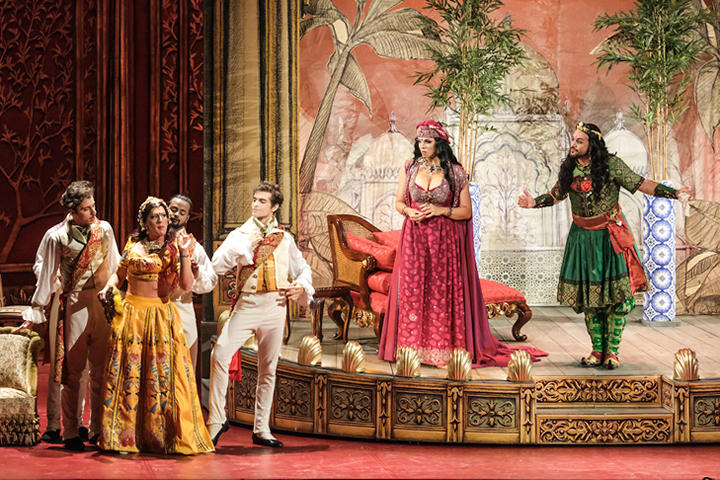| Opera Reviews | 27 July 2024 |
A fun and playful resurrection of Vinci's operaby Catriona Graham |
|
Vinci: Alessandro nell'Indie
|
|

|
|
|
Some operas just have the wrong name - like films ‘starring’ a big name, to pull in the punters, when s/he only has a cameo role. Alessandro nell’Indie’, by Leonardo Vinci to Metastasio’s libretto, is really about Poro and Cleofide, with Alessandro himself having a bit part. And, rather than high drama about military conquest, its soap opera storyline would not be out of place in Coronation Street; newcomer disrupts existing relationships, words are said, feelings expressed, etc. Director Max Emanuel Cencic takes this domesticity further, in this Bayreuth Baroque production, by setting the action in the Brighton Pavilion. After a rather good dinner, George IV and his guests – a bunch of actors and other disreputable friends – have the happy idea of some impromptu am dram. As you do. The result is some high intensity comedy verging on pantomime, with everyone piling in enthusiastically. Choreographer Sumon Rubra’s Bollywood-inspired dance at times also shows a debt to Les Trocs. As time wears on, however, and the players (in both senses of the word) get into their parts, the mood changes. With an all-male cast – as in its first performance back in 1730 – the last thing to expect is a coloratura soprano, but that is what Bruno di Sá provides as Cleofide. Not only that, he could ring tears from a stone. As Poro, Franco Fagioli is excellent, with a creamy tone to his highest notes. When he and Cleofide – king and queen of separate territories and in love with each other – have a ‘domestic’, it turns into a sing-off in which di Sá’s ornamentation in the repeated A section turns into that Queen of the Night passage. Fagiolini’s riposte is La Donna è mobile. The onstage audience takes sides … Such high jinks should not deafen us to the riches elsewhere. Jake Arditti sneaks a bit of Carmen into his ornamentation as Erissena, sister of Poro. In Act 3’s Come condore, he sings with such richness and warmth of tone, when Alessandro finds the note of the plot – you did realise there would be a note and a plot, didn’t you – and Erissena laments being found out. His voice contrasts well with Stefan Sbonnik, who has great fun as Gandarte, somewhat irreverent side-kick to Poro and in love with Erissena. He is a bit of a clown to start with but develops into something akin to a baddie. The nearest to a real baddie is Timagene (Nicholas Tamagna), who has the thankless task of betraying everyone – or so it seems. And then there is Alessandro. Maayan Licht plays him with a elegance and delicious high notes, Giuseppe Palella’s costumes are splendid - Alessandro and Timagene in Regency breeches and velvet tailcoats, the Indians in opulent silks heavily embossed with gold, silver and jewels. The dancing boys are variously in European and Indian dress, the girls always in Indian. The costume changes are many and varied – and many are very quick. Tamara Mascara’s advice on Drag Queen makeup has been well-used - Cleofide and Erissena are beautiful. The running gag of arrivals and departures made on a couple of tricycle elephants and a recalcitrant camel, which needs to be coaxed to move forward or back, is kept going throughout. People and props are produced from chests. Erissena tries to eavesdrop on Cleofide and is chased about and harangued by her. In Destrier, che all’armi usato, Poro is almost upstaged by a particularly acrobatic dancer, whose grace and agility is outstanding. The baroque stage is replicated in a smaller version which rolls on and off for certain scenes, complete with its own scallop-shell footlights. This production – the first since 1740 – is exemplary in being constrained neither by the conventions of its original time nor by those of our own times. It is enormous fun and playful, without compromising the music. The singing is superb, as is the playing of the (oh!) Orchestra, whose musical director Martyna Pastuszka joins Poro onstage for Se possone tanto due luci vezzose. The double bass duet with Timagene is just one of many such delights. Overall, Cencic and the rest of the team have shown that this opera does deserve to be revived. |
|
Photo © Bayreuth Baroque / Falk von Traubenberg |
|







